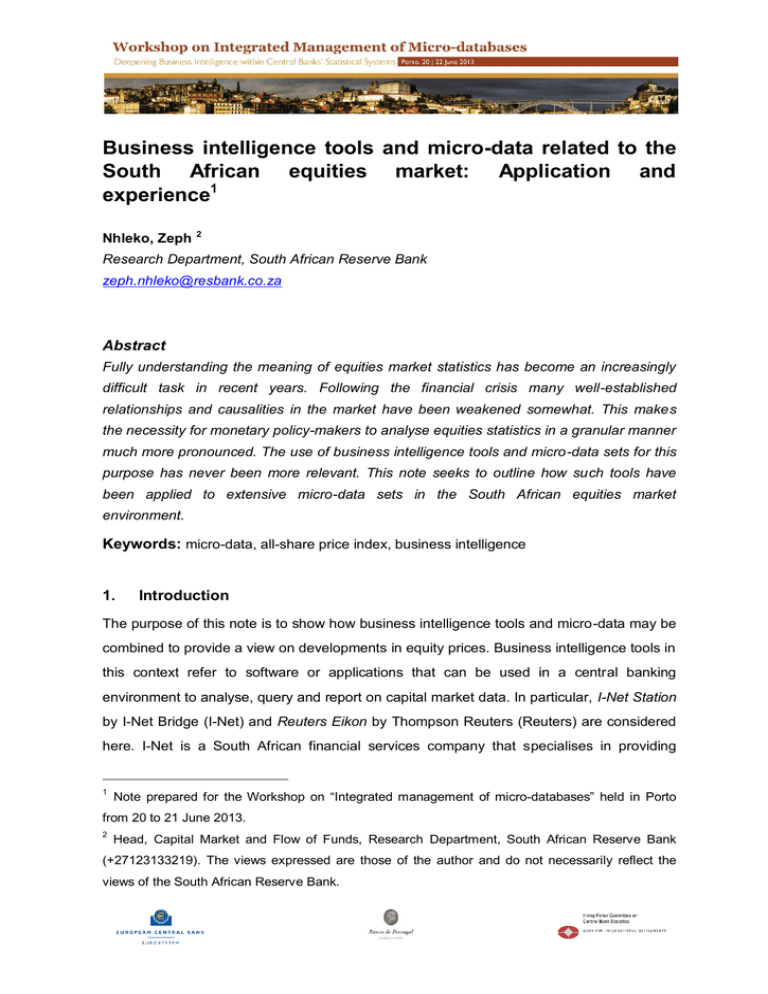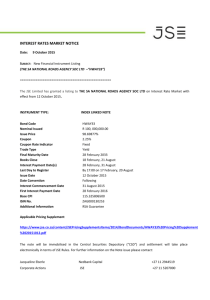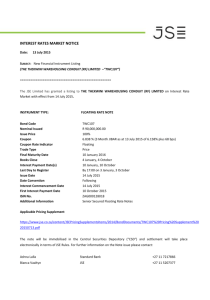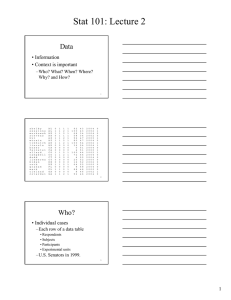Business intelligence tools and micro-data ... South African
advertisement

Business intelligence tools and micro-data related to the South African equities market: Application and experience1 Nhleko, Zeph 2 Research Department, South African Reserve Bank zeph.nhleko@resbank.co.za Abstract Fully understanding the meaning of equities market statistics has become an increasingly difficult task in recent years. Following the financial crisis many well-established relationships and causalities in the market have been weakened somewhat. This makes the necessity for monetary policy-makers to analyse equities statistics in a granular manner much more pronounced. The use of business intelligence tools and micro-data sets for this purpose has never been more relevant. This note seeks to outline how such tools have been applied to extensive micro-data sets in the South African equities market environment. Keywords: micro-data, all-share price index, business intelligence 1. Introduction The purpose of this note is to show how business intelligence tools and micro-data may be combined to provide a view on developments in equity prices. Business intelligence tools in this context refer to software or applications that can be used in a central banking environment to analyse, query and report on capital market data. In particular, I-Net Station by I-Net Bridge (I-Net) and Reuters Eikon by Thompson Reuters (Reuters) are considered here. I-Net is a South African financial services company that specialises in providing 1 Note prepared for the Workshop on “Integrated management of micro-databases” held in Porto from 20 to 21 June 2013. 2 Head, Capital Market and Flow of Funds, Research Department, South African Reserve Bank (+27123133219). The views expressed are those of the author and do not necessarily reflect the views of the South African Reserve Bank. economic data, financial market data and corporate market intelligence in South Africa. Reuters provides a synthesis of human intelligence, industry expertise and innovative technology to deliver insight to, among others, financial, risk, legal, tax and accounting markets. Micro-data on the other hand is used here to refer to individual listed company data on South Africa’s stock exchange, the JSE Limited (JSE). Such data includes volumes, values and prices at company level in the market. 2. Rationale for using equities market micro-data to assess equity price developments in South Africa The focus of this note is on equities and, in particular, trying to understand the role of duallisted shares on the overall all-share price index (Alsi) of the JSE. The Alsi is a free-float, market capitalization weighted index that tracks the performance of all companies listed on the JSE. It is the broadest and representative measure of the exchange’s performance. There is a view3 that dual listed shares may reflect offshore sentiment or developments and the rand exchange rate movements – and may as such influence the overall share market in South Africa. This view finds further support from the fact that the weight of duallisted shares on the Alsi is over 65 per cent. However the concept of dual listing can be confusing at times4 and must be carefully interpreted – a couple of points are important in this regard. Firstly, the extent of dual listing (in percentages) varies across companies and this may affect the level of impact such shares may have on the domestic market. Secondly, the standard dual listing status of a company does not take into account depository receipts, i.e., negotiable financial instruments issued by banks to represent foreign companies’ publicly listed shares. Although some companies listed on the JSE do not have secondary listings, they have depository receipt programs with banks offshore. Typically these banks list the shares on offshore exchanges to be traded by non-residents. Thirdly, some companies, even though they are only listed domestically, have foreign ownership in excess of 50 per cent, which should make them susceptible to offshore sentiment and 3 For example, (1) Internal discussions, (2) Uranium One prejudiced by JSE rules, http://www.miningmx.com/..._site_id=83 and (3) Arbitrage opportunities on dual-listed stocks http://www.moneyweb.co.za/...-duallisted-stocks. 4 E-mail response to questions posed, Mark Randall, Manager – Indices: Post Trade Services, JSE Limited. 2 developments. Fourthly, the objective for buying certain shares may actually have nothing to do with investor sentiment or economic factors for that matter, as such shares are bought to be defensive or for growth purposes. Lastly, the proportion of revenue earned in South Africa will make shares sensitive to a certain degree to domestic factors. However one assessment that can be done to check the validity of this view is to analyse the drivers of each share on the JSE. Another assessment is to compute separate indices for dual-listed shares (DLSi) and non-dual-listed shares (NDLSi) for South Africa. Similar to the Alsi, these indices should be weighted indices that include/exclude the dual-listed companies in order to capture the supposedly domestic economic and other influences on share prices. Companies whose dual listing is in Africa need not be excluded from the index as the impact of their share price movements would be minimal on the JSE. Based on current listing and for purposes of calculating these indices, “dual-listed” means outside of Africa. There are several ways of compiling indices, but the two most basic formulae for computing indices are the Paasche and Laspeyres5 methodologies. The only real difference between them is that the Paasche index uses the number (n) of quantities and the Laspeyres index uses base period (0) quantities. The indices take the following forms respectively; and where p is the price level, t0 is the base period and tn is the number of periods for which the index is computed. Adapting the Laspeyres methodology and in line with JSE’s index calculation technique, the proposed DLSi and NDLSi can take the form; where N is the number of securities in the index, pi is the latest share price, si is the number of shares issued or traded, fi is the investability factor (free float weighting) and d is the divisor representing all issued shares at the base period. The divisor changes with the issued shares in order to avoid distorting the index. 5 Etienne Laspeyres, 1871 and Herman Paasche, 1874. 3 3. Business intelligence tools and the compilation of an alternative all share price index The process of calculating the separate indices requires micro-data at individual company level, such as share prices and individual company volumes of shares traded on a daily basis. I-Net and Reuters allow for collecting these types of data over time. These tools allow company code names to be identified separately and used to compile a matrix with share prices, volumes traded, market capitalisation and similar variables. Individual company code names can also be used to check and verify company registration/deregistration dates with the JSE – this is important information for maintaining the index, i.e., the process of adjusting the index divisor. 4. Conclusion Figure 1 shows that, although fluctuations are more pronounced, the average prices of non-dual-listed shares increased by 96 per cent from February 2009 to April 2013, much faster than dual-listed share prices at 67 per cent. The overall Alsi increased by 87 per cent over this period. The differential between the Alsi, DLSi and NDLSi represent a confluence of domestic and offshore factors that affect domestic share prices. Therefore the view that dual-listed shares drive the Alsi more than other factors is has no solid basis. Further analysis is required. Figure 1. Share prices Share price growth 1000 900 800 Index = 2 January 2009 700 600 500 400 300 200 2009 Non-Dual-Listed share index 2010 2011 2012 2013 Dual-Listed share index 4 All-share price index 180 Index = 2 January 2009 160 140 120 100 80 2009 2010 2011 2012 2013 REFERENCES − Capital Market and Flow of Funds, 2012 (March): Cheapness of the South African equity market – a perspective on PE ratios, Unpublished. − Capital Market and Flow of Funds, 2012 (July): Performance of the All-share Price Index (Alsi) and some of its drivers, Unpublished. − Capital Market and Flow of Funds, 2012 (August): Is the compensation for holding shares vs. bonds negative?, Unpublished. − Chance, W.A. 1966. A note on the origins of index numbers, The Review of Economics and Statistics, 48 (1). February, pp. 108 – 110. − FTSE/JSE. 2004. Guide to calculation methods for the FTSE/JSE Africa index series. − FTSE/JSE. 2004. Guide to calculation methods for the UK series of the FTSE Actuaries share indices. − FTSE/JSE. 2012. Ground rules for the management of the FTSE/JSE Africa index series. − I-Net Bridge, 2013. http://www.inet.co.za/#about_us/company_prof.php. Accessed 10 April 2013. − S&P Indices. 2012. Index mathematics methodology − Thompson Reuters, 2013. http://thomsonreuters.com/about/. Accessed 10 April 2011. 5



